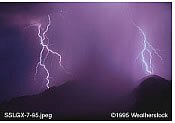|
|

WHAT IS LIGHTNING?

Lightning
Lightning always accompanies a thunderstorm. It is estimated that lightning hits the Earth 100 times each second. That's 8.6 million strikes per day and over three billion each year.
Lightning is five times hotter than the sun. A single bolt can reach 50,000 degrees Fahrenheit.
|
 |
Lightning is an electrical discharge produced to balance the differences between positive and negative charges within a cloud, between two clouds, or between the cloud and the ground.
You've heard the expression, "opposites attract." |
Well, this is exactly what happens with cloud-to-ground lightning.
A negative charge at the base of the cloud is attracted to a positive charge at the earth's surface. This charge is densest on isolated or protruding objects, like trees and tall buildings. When the difference between these charges becomes sufficiently strong, the normal insulating qualities of the air break down and a lightning bolt strikes.
What occurs as an instantaneous flash to the human observer actually is a complex progression of events. First, a usually invisible discharge of electrons races down from the cloud. This downward moving bolt of negatively charged electricity (called a stepped leader) incites a discharge of positively charged electricity from the ground.
This second bolt races upward to meet the descending charge, and it is when they connect that the luminous flash of electricity we know as lightning races up from the ground to the cloud in perhaps 1/10,000th of a second. This final step in the lightning process is called a "return stroke."
During a thunderstorm, not only is the ground positively charged, so is everything on it. The tallest object in the area is most likely to be struck, whether it is a building, a tree, or a person standing alone in a field.
Different Types
Although cloud-to-ground lightning strikes pose the most danger to people on the ground, they make up only about 20% of all lightning strikes. The most common type of lightning in a thunderstorm is in-cloud lightning, which occurs within the cloud itself.
Cloud-to-cloud lightning is a common occurrence in which opposite electrical charges in one cloud attract those in another.
An extremely rare form of lightning is called ball lightning. It is so rare that scientists often question its existence. Those who have witnessed ball lightning describe it as a round ball of fire seen on telephone wires or entering through windows and doors during a thunderstorm.
Then there's heat lightning. Heat lightning has nothing to do with how warm temperatures are on a summer's night. It is actually lightning seen from a distant thunderstorm too far away for the thunder to be heard.
Just The Facts
|
|
|
|

